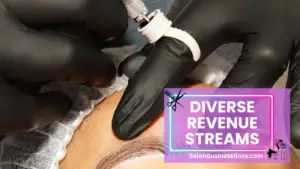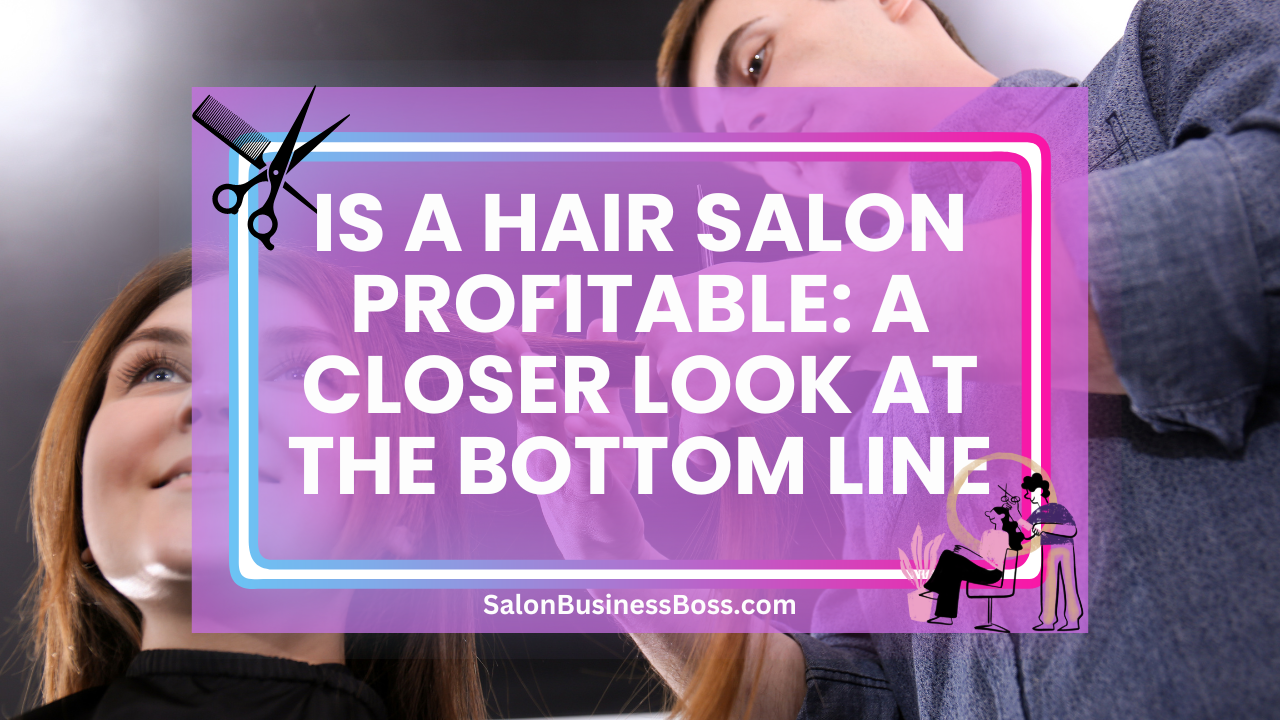The hair salon industry is a thriving sector that caters to a vast clientele seeking various hair-related services, including haircuts, styling, coloring, and treatments. With an ever-increasing focus on personal grooming and appearance, hair salons play a significant role in enhancing one’s self-image.
Yes, a hair salon is profitable due to steady demand, customer loyalty, upselling, diverse revenue streams, effective marketing, and cost control. With a focus on exceptional service and expanding offerings, salons can tap into a thriving market and achieve long-term profitability.
1. Steady Demand and Market Growth:

The profitability of hair salons is rooted in the unwavering demand for their services. Regardless of economic conditions, people consistently seek professional hair care and styling, making it a recession-resilient industry. Personal grooming is a priority for individuals, even during tightening budgets, and this consistent need ensures a steady flow of customers.
The market for hair salon services continues to expand, bolstering their profitability. As populations grow, the potential customer base increases, providing more opportunities for salons to attract clients. Additionally, evolving fashion trends play a significant role in driving demand. With each passing season, new hairstyles, coloring techniques, and grooming services emerge, enticing customers to visit salons to update their looks and maintain their desired appearances.
In the competitive beauty industry, staying current with the latest trends is paramount. Hair salons that adapt to these shifts and offer the latest services will attract more customers and maintain a loyal clientele. This adaptability ensures that the demand for salon services remains constant and creates a favorable environment for profitability.
As the world becomes more interconnected, social media and digital platforms play a pivotal role in fueling the demand for hair salon services. Influencers and celebrities often set hair and grooming trends, inspiring people worldwide to imitate these styles. As a result, customers seek professional salons to achieve these coveted looks, further contributing to the industry’s profitability.
The sustained demand for hair salon services also presents an opportunity for expansion and diversification. Savvy salon owners can capitalize on the market growth by introducing new beauty services, such as manicures, pedicures, and facials, in addition to the traditional haircare offerings. By diversifying their service portfolio, salons can attract a broader customer base and tap into cross-selling opportunities, driving higher revenues and profitability.
Read more about: How to Run a Successful Hair Salon: Salon Management and Efficiency
2. Repeat Business and Customer Loyalty:
Customer loyalty is a cornerstone of profitability for hair salons. The importance of repeat business cannot be overstated, as satisfied customers are not only likely to return for future services but also become brand ambassadors, recommending the salon to their friends and family. Building a loyal customer base is crucial for sustained success in the competitive beauty industry.
To achieve customer loyalty, hair salons must prioritize customer satisfaction above all else. Providing excellent services is at the heart of retaining clients. Skilled and experienced stylists who can deliver the desired haircuts, colors, and styles play a significant role in ensuring clients leave the salon satisfied and happy with their appearance.
Beyond technical expertise, creating a pleasant ambiance in the salon is equally essential. A clean, well-designed, and comfortable salon environment contributes to a positive overall experience for customers. This attention to detail demonstrates the salon’s commitment to providing a top-notch experience, reinforcing the perception of quality and value for money.
Personalized attention is another key aspect of fostering customer loyalty. Salon staff should take the time to understand each client’s unique preferences, hair type, and style goals. By establishing a genuine connection with clients and addressing their specific needs, salons can build trust and rapport, making clients feel valued and understood.
Effective communication with clients is essential for building customer loyalty. Taking the time to listen to clients’ concerns, answering their questions, and providing professional advice builds confidence in the salon’s expertise. A transparent and open line of communication fosters trust, which is crucial for client retention.
Implementing customer loyalty programs can also incentivize repeat business. Rewarding loyal customers with discounts, special offers, or exclusive access to new services can entice them to return regularly and stay committed to the salon.
Word-of-mouth referrals are potent marketing tools, and satisfied customers are more likely to recommend the salon to their social circle. Positive reviews and personal recommendations carry considerable weight, attracting new clients and expanding the salon’s customer base.
3. Upselling and Add-On Services:
Maximizing revenue per customer is a key strategy for a profitable hair salon. By employing effective upselling techniques and offering enticing add-on services, salons can enhance the overall customer experience while boosting their earnings.
Upselling involves suggesting additional services or products that complement the customer’s primary choice. For instance, after a haircut, the stylist might propose a deep conditioning treatment to nourish and revitalize the hair. By presenting this option as a way to enhance the haircut’s longevity and maintain healthy locks, customers are more likely to opt for the add-on service.
Add-on services can elevate the salon experience, providing customers with an extra touch of pampering and relaxation. Treatments like hair spa sessions or scalp massages offer a luxurious indulgence that clients appreciate, leaving them feeling rejuvenated and satisfied with the overall salon visit. These memorable experiences encourage repeat business and word-of-mouth referrals.
Upselling hair care products is another effective strategy for increasing revenue. Skilled stylists can recommend the ideal shampoos, conditioners, and styling products tailored to the customer’s hair type and style. By explaining the benefits of these products and demonstrating how they complement the newly styled hair, the salon showcases its commitment to the customers’ hair well-being.
Selling hair care products can be a lucrative revenue stream for salons. Stocking high-quality, professional-grade products enables the salon to provide clients with the means to maintain their hairstyles at home, fostering loyalty and trust in the salon’s expertise.
To successfully implement upselling and add-on services, staff training is essential. Stylists should be well-versed in the features and benefits of each treatment and product, enabling them to make informed and persuasive recommendations to clients. Additionally, it’s crucial to strike a balance between upselling and overwhelming clients. The focus should always be on enhancing the customer experience rather than aggressive sales tactics.
4. Diverse Revenue Streams:

Diversification of revenue streams is a key strategy adopted by many successful hair salons to increase profitability and ensure long-term sustainability. Beyond offering traditional hair services, these salons expand their offerings to include a wide range of beauty services that cater to a broader clientele.
Beauty services such as manicures, pedicures, facials, and waxing not only attract new customers but also create cross-selling opportunities. A client who visits the salon for a haircut may be enticed to try other beauty treatments, leading to increased spending per visit. This not only boosts the salon’s revenue but also enhances the overall customer experience, making the salon a one-stop-shop for various grooming needs.
By incorporating beauty services, salons can tap into different market segments, expanding their customer base and strengthening their position in the competitive beauty industry. Offering comprehensive beauty packages and bundling services can encourage customers to try multiple treatments at once, increasing the salon’s profitability per client.
Some hair salons have successfully ventured into retail by establishing dedicated sections where they sell hair care products, hair accessories, and branded merchandise. Retailing professional-grade hair care products allows the salon to extend the salon experience to the client’s home. Clients appreciate the convenience of purchasing the same high-quality products used during their salon visit, fostering loyalty and trust in the salon’s expertise.
The retail aspect also serves as an additional revenue stream for the salon. By curating a selection of hair care products and accessories that complement the salon’s services, the salon can generate consistent income from product sales. As the salon builds a reputation for quality and customer satisfaction, clients are more likely to trust and purchase products recommended by their stylist.
Diversified revenue streams not only boost overall profitability but also act as a safety net during potential downturns in specific services. For instance, during slow periods for hair services, beauty treatments and retail sales can help maintain revenue stability, reducing the salon’s reliance on a single revenue source.
Read more about: How to Run a Flourishing Salon: Steps to Achieve Growth
5. Effective Marketing and Branding:
In the digital age, a strong online presence and effective marketing strategies are essential for the success and profitability of hair salons. With the majority of consumers relying on the internet for information and recommendations, harnessing the power of digital media becomes crucial for attracting and retaining customers.
Professional branding is the foundation of a salon’s online identity. Creating a distinct and memorable brand that reflects the salon’s values, style, and unique offerings helps it stand out in a crowded market. A well-designed logo, color scheme, and consistent messaging across all platforms create a cohesive and professional image that resonates with potential clients.
Maintaining an active online presence is equally vital. Social media platforms such as Instagram, Facebook, and Twitter provide an excellent platform for showcasing the salon’s work, sharing customer testimonials, and engaging with the audience. By regularly posting high-quality images and videos of hairstyling transformations, behind-the-scenes glimpses, and informative content, the salon can capture the attention of potential clients and keep existing ones engaged.
Online reviews and testimonials play a significant role in influencing consumer decisions. Positive reviews build trust and credibility, while constructive feedback helps the salon identify areas for improvement. Actively seeking customer feedback and promptly responding to reviews demonstrate a commitment to customer satisfaction and showcase the salon’s dedication to continuous improvement.
Strategic marketing campaigns are effective in reaching a broader audience and attracting new clients. By identifying target demographics and tailoring marketing messages to resonate with their needs and preferences, salons can maximize the impact of their advertising efforts.
Seasonal promotions are also a valuable marketing tool to drive sales during specific times of the year. Offering special discounts, packages, or themed services related to holidays or seasonal trends can create a sense of urgency and encourage clients to book appointments promptly.
Loyalty programs are another effective way to boost profitability. Rewarding repeat customers with exclusive discounts, free services, or referral incentives not only strengthens customer loyalty but also encourages clients to increase their spending per visit to unlock more rewards.
6. Cost Control and Efficiency:
Cost control and efficiency are critical aspects of running a profitable hair salon. Managing overhead costs effectively allows the salon to allocate resources wisely, ensuring that each expense contributes to the salon’s profitability.
One of the most significant overhead costs for hair salons is rent. Securing a location in a strategic area that attracts the target clientele is crucial. However, renting a large and expensive space can burden the salon with unnecessary costs. A profitable salon carefully assesses the location’s foot traffic, demographic fit, and rental costs to strike the right balance between visibility and affordability.
Utilities, such as electricity and water, also impact the salon’s expenses. Implementing energy-efficient practices, like using LED lighting and low-flow fixtures, can lead to substantial savings in the long run. Setting thermostats at comfortable yet cost-effective levels and ensuring proper insulation further optimizes utility expenses.
Managing staffing costs is another essential aspect of cost control. A profitable salon optimizes its workforce, ensuring the right number of stylists are scheduled during peak hours and that staffing levels match client demand. Utilizing part-time or freelance stylists during slow periods can help reduce labor costs without compromising service quality.
Smart inventory management is crucial for minimizing expenses. Keeping track of salon supplies and ordering in bulk can lead to discounts and better pricing from suppliers. Avoiding excess inventory helps reduce waste and prevents tying up unnecessary capital in stock that might not be used promptly.
Efficient time management is a key factor in maximizing profitability. Ensuring that appointments are scheduled optimally allows the salon to accommodate more clients throughout the day. A well-organized appointment book minimizes downtime and ensures that stylists are consistently engaged, maximizing their productivity.
Offering online booking options and reminders can help reduce no-shows and last-minute cancellations, which can disrupt the salon’s schedule and lead to lost revenue.
Implementing technology in salon operations, such as point-of-sale systems and salon management software, streamlines administrative tasks and reduces the potential for errors in billing and inventory management.
Conclusion
Hair salons are indeed profitable enterprises, and several factors contribute to their continued success. From steady demand and customer loyalty to diverse revenue streams and effective marketing, a well-managed hair salon can achieve significant profitability. By prioritizing customer satisfaction, maintaining operational efficiency, and staying attuned to market trends, salon owners can build thriving businesses that cater to the ever-growing desire for personal grooming and self-expression.
Frequently Asked Questions

1. What role does branding play in a salon’s profitability?
Effective branding creates a unique identity, enhances customer perception, and differentiates the salon from competitors, positively impacting profitability.
2. Can salon owners benefit from customer feedback?
Absolutely. Customer feedback provides valuable insights for improving services, addressing concerns, and fostering better relationships, leading to increased loyalty and profitability.
3. Are hair salon franchise opportunities profitable?
Franchising can be a profitable option, as established brands often come with built-in customer bases and standardized business models that can streamline operations and boost profitability. However, success still depends on local factors and the owner’s efforts.
To learn more on how to start you own salon checkout my startup documents here.
Please note that the contents of this blog are for informational and entertainment purposes only and should not be construed as legal advice. Any action taken based on the information provided in this blog is solely at your own risk. Additionally, all images used in this blog are generated under the CC0 license of Creative Commons, which means they are free to use for any purpose without attribution.

About the author. Entrepreneur and Salon Business Fan.
Hi! I am Shawn and I am a happy individual who happens to be an entrepreneur. I have owned several types of businesses in my life from a coffee shop to an import and export business to an online review business plus a few more and now I create online salon business resources for those interested in starting new ventures. It’s demanding work but I love it. I do it for those passionate about their business and their goals. That’s why when I meet a salon business owner, I see myself. I know how hard the struggle is to retain clients, find good employees and keep the business growing all while trying to stay competitive.
That’s why I created Salon Business Boss: I want to help salon business owners like you build a thriving business that brings you endless joy and supports your ideal lifestyle.


